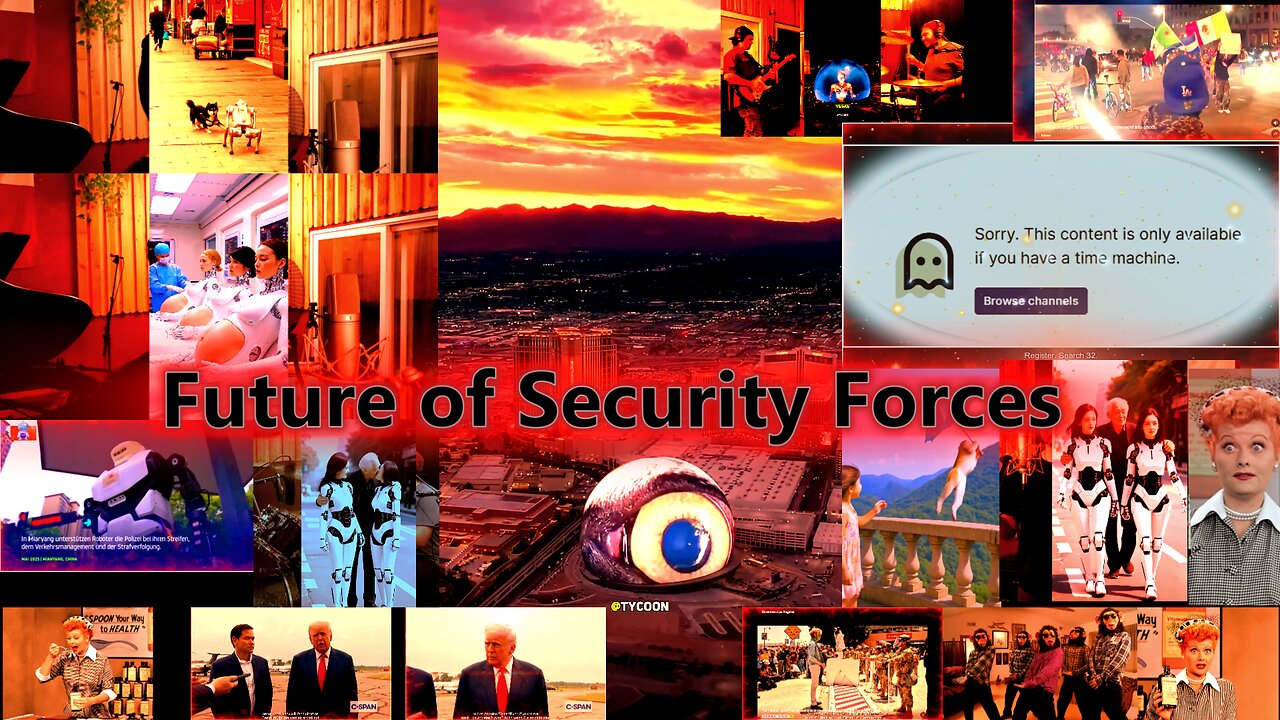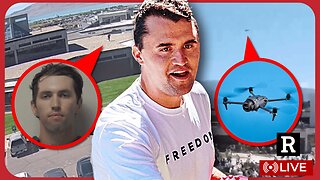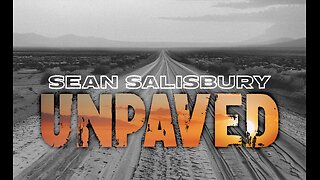Premium Only Content

Future of Security Forces: AI Robots to Combat Riots in Los Angeles?
Welcome to the QF Rumble Studio – where chaos meets creativity!
Immerse yourself in a wild mix of action, humor, and pure entertainment! In this episode, you can expect:
Robot dogs taking over the streets! From interactive Dog-E robots to dancing, barking high-tech pets – we show you the coolest gadgets that not only wag their tails, but also steal the show! (Inspired by the latest robotics trends: Mintid Dog-E, FUUY Robot Dog, and more!)
... We'll take you on a visual journey to the futuristic Las Vegas Sphere – a spectacle that will leave you speechless! Las Vegas Sphere Short
Lucy, slightly tipsy! A throwback to the legendary I Love Lucy episode, where Lucy Ricardo delivers hilarious moments as the Vitameatavegamin girl. From squeamish sips to drunken mayhem, this scene is timeless!
Bruno Mars' Lazy Song! We crank up the speakers with Bruno Mars' chilled-out hit, filmed in Diana Ross's daughter's living room, featuring the iconic Poreotics dancers in monkey masks. Perfect for lifting the spirits! Bruno Mars - The Lazy Song...
--
News Summary and Outlook: AI Robots to Combat Riots in Los Angeles
Summary
The city of Los Angeles may be on the cusp of a new era of security measures, inspired by developments in other cities such as San Francisco. Police there received permission in 2022 to use remote-controlled robots in potentially lethal situations, such as disorienting armed criminals with explosive devices. While no concrete plans to use AI robots to combat riots in Los Angeles have been publicly confirmed, reports of protests in the city (such as the one in the provided SRT transcript) and global advances in robotics point to a possible future in which autonomous systems could play a role in riot control. The SRT transcript describes protests in Los Angeles in which demonstrators took to the streets against police brutality and racism, posing public safety challenges for the city. The use of AI-controlled robots, as already being tested in military contexts, could be discussed as a solution to increase the safety of police officers and minimize escalations.
Technological Context
The development of AI robots for security and military purposes is progressing rapidly. In San Francisco, the police department has twelve remote-controlled robots, which are currently used for bomb disposal or reconnaissance, but could potentially be equipped with lethal weapons. Countries around the world, such as the USA, China, and Russia, are working on autonomous weapons systems (LAWS) that can independently identify and attack targets. Examples include the Turkish Kargu drone, which autonomously attacked a human in Libya in 2020, and China's robot dogs with machine guns, which could be operational within two years. Such technologies could theoretically be adapted for riot control, for example through swarms of drones or robots that recognize faces and analyze situations. The Los Angeles Fire Department already uses remote-controlled robots like the RS3 for dangerous missions, demonstrating that the city is open to robotic support.
Outlook
If Los Angeles plans to use AI robots for riot control, remote-controlled or semi-autonomous systems could initially be used for de-escalation, such as through surveillance or non-lethal means like tear gas. The technology could protect police officers by keeping them out of dangerous situations, as argued in San Francisco. However, there are significant challenges:
Ethical concerns: Critics such as Human Rights Watch and academics (e.g., Stephen Hawking, Elon Musk) warn against autonomous weapons systems because, without human control, they could misidentify targets, resulting in disproportionate collateral damage. In riots, this could endanger innocent protesters.
Legal questions: Who is responsible if a robot injures a civilian? The manufacturer, the operator, or the police? These questions remain unresolved, as experts in San Francisco point out.
Societal impact: The use of AI robots could further undermine trust in the police, especially in communities already protesting police violence, as described in the SRT transcript. Activists fear that such systems could increase discrimination, for example through faulty facial recognition.
Technological feasibility: While swarm technologies and AI-controlled drones are making progress in military contexts, they are not yet fully adapted for urban use. The cost of developing such systems could also be a barrier.
Conclusion
Without concrete evidence of plans in Los Angeles, the use of AI robots to combat riots remains speculative. However, technological advances and precedents in other cities suggest that such systems could be conceivable in the near future. Los Angeles could benefit from remotely controlled robots like the RS3 or drone swarms to enhance security, but would need to overcome ethical, legal, and societal hurdles. An international consensus on the regulation of autonomous systems, as called for by the UN, would be crucial to prevent misuse. The protests, as described in the SRT transcript, underscore the urgency of using such technologies responsibly to prevent further escalation of conflicts.
--
News Summary and Outlook: AI Robots to Combat Riots in Los Angeles
Summary
The city of Los Angeles may be on the cusp of a new era of security measures, inspired by developments in other cities such as San Francisco. Police there received permission in 2022 to use remote-controlled robots in potentially lethal situations, such as disorienting armed criminals with explosive devices. While no concrete plans to use AI robots to combat riots in Los Angeles have been publicly confirmed, reports of protests in the city (such as the one in the provided SRT transcript) and global advances in robotics point to a possible future in which autonomous systems could play a role in riot control. The SRT transcript describes protests in Los Angeles in which demonstrators took to the streets against police brutality and racism, posing public safety challenges for the city. The use of AI-controlled robots, as already being tested in military contexts, could be discussed as a solution to increase the safety of police officers and minimize escalations.
Technological Context
The development of AI robots for security and military purposes is progressing rapidly. In San Francisco, the police department has twelve remote-controlled robots, which are currently used for bomb disposal or reconnaissance, but could potentially be equipped with lethal weapons. Countries around the world, such as the USA, China, and Russia, are working on autonomous weapons systems (LAWS) that can independently identify and attack targets. Examples include the Turkish Kargu drone, which autonomously attacked a human in Libya in 2020, and China's robot dogs with machine guns, which could be operational within two years. Such technologies could theoretically be adapted for riot control, for example through swarms of drones or robots that recognize faces and analyze situations. The Los Angeles Fire Department already uses remote-controlled robots like the RS3 for dangerous missions, demonstrating that the city is open to robotic support.
Outlook
If Los Angeles plans to use AI robots for riot control, remote-controlled or semi-autonomous systems could initially be used for de-escalation, such as through surveillance or non-lethal means like tear gas. The technology could protect police officers by keeping them out of dangerous situations, as argued in San Francisco. However, there are significant challenges:
Ethical concerns: Critics such as Human Rights Watch and academics (e.g., Stephen Hawking, Elon Musk) warn against autonomous weapons systems because, without human control, they could misidentify targets, resulting in disproportionate collateral damage. In riots, this could endanger innocent protesters.
Legal questions: Who is responsible if a robot injures a civilian? The manufacturer, the operator, or the police? These questions remain unresolved, as experts in San Francisco point out.
Societal impact: The use of AI robots could further undermine trust in the police, especially in communities already protesting police violence, as described in the SRT transcript. Activists fear that such systems could increase discrimination, for example through faulty facial recognition.
Technological feasibility: While swarm technologies and AI-controlled drones are making progress in military contexts, they are not yet fully adapted for urban use. The cost of developing such systems could also be a barrier.
Conclusion
Without concrete evidence of plans in Los Angeles, the use of AI robots to combat riots remains speculative. However, technological advances and precedents in other cities suggest that such systems could be conceivable in the near future. Los Angeles could benefit from remotely controlled robots like the RS3 or drone swarms to enhance security, but would need to overcome ethical, legal, and societal hurdles. An international consensus on the regulation of autonomous systems, as called for by the UN, would be crucial to prevent misuse. The protests, as described in the SRT transcript, underscore the urgency of using such technologies responsibly to prevent further escalation of conflicts.
--
Bakin' in the Sun (Rippleberry),
07.08.2022, From the album 'Vibin' Around Town' https://rippleberrymusic.com
From "You can read along in the transcript":
You said you were wow
Ohio
And your father's still sitting in a jail cell
Drawn a thousand miles here
You sold everything you had to sell
Now you're lost in the aisle
You're waiting for someone to dress you
The shelf
Come on, baby
Come on, baby, in the sun
--
Bakin' in the Sun
Déjà-Vibes
https://music.apple.com/us/artist/deja-vibes/1579748326
Bruno Mars - The Lazy Song (Official Video)
[Verse 1]
I'm gonna kick my feet up, then stare at the fan
Turn the TV on, throw my hand in my pants
Nobody's gon' tell me I can't, nah
I'll be lounging on the couch, just chillin' in my Snuggie
Click to MTV, so they can teach me how to dougie
'Cause in my castle, I'm the freaking man
[Pre-Chorus]
Oh-oh, yes, I said it (Ooh-ooh)
I said it, I said it, 'cause I can (Ooh-ooh-ooh-ooh-ooh-ooh)
[Chorus]
Today, I don't feel like doing anything
I just wanna lay in my bed
Don't feel like picking up my phone
So leave a message at the tone
'Cause today, I swear, I'm not doing anything
Nothing at all
Woo-hoo, woo-hoo, ooh
Nothing at all
Woo-hoo, woo-hoo, ooh
-
 2:21:09
2:21:09
Redacted News
4 hours agoWhat are they hiding? New video evidence in Charlie Kirk's Shooting SHAKES FBI'S case | Redacted
144K287 -
 41:53
41:53
Kimberly Guilfoyle
6 hours agoCharlie's Legacy and Our Mission
42.4K8 -
 1:07:55
1:07:55
vivafrei
5 hours agoJimmy Kimmel Out Indefinitely! Trump "Srubs" Study on Right Wing Violence? Clinton Tweet & MORE
206K80 -
 1:35:02
1:35:02
The Quartering
6 hours agoNuclear Fallout From Jimmy Kimmel Firing, New Head Of TP USA, Obama Whines
231K75 -
 23:35
23:35
Jasmin Laine
4 hours ago“We Were Betrayed”—Carney HUMILIATED As His Base REVOLTS Against Him
40.7K26 -
 LIVE
LIVE
LFA TV
21 hours agoKIMMEL GONE | ANTIFA LABELED TERRORISTS! - THURSDAY 9/18/25
740 watching -
 2:21:28
2:21:28
freecastle
8 hours agoTAKE UP YOUR CROSS- Hope In GOD, and Fear NO Evil!
20.4K9 -
 1:34:10
1:34:10
The HotSeat
5 hours agoChapter 32 Begins: Honoring Charlie Kirk’s Legacy & Jimmy Kimmel Gets Canceled
27.7K9 -
![[Ep 751] Jimmy Kimmel – You’re Fired! | Freedom of Speech is Not Freedom From Consequence](https://1a-1791.com/video/fww1/bd/s8/1/e/-/h/j/e-hjz.0kob-small-Ep-751-Jimmy-Kimmel-Youre-F.jpg) 3:11:10
3:11:10
The Nunn Report - w/ Dan Nunn
5 hours ago[Ep 751] Jimmy Kimmel – You’re Fired! | Freedom of Speech is Not Freedom From Consequence
33.7K7 -
 1:28:39
1:28:39
Sean Unpaved
8 hours agoBills-Dolphins TNF Battle, Steelers' D in Crisis, & Coaching Hot Seat Alert!
50.9K1